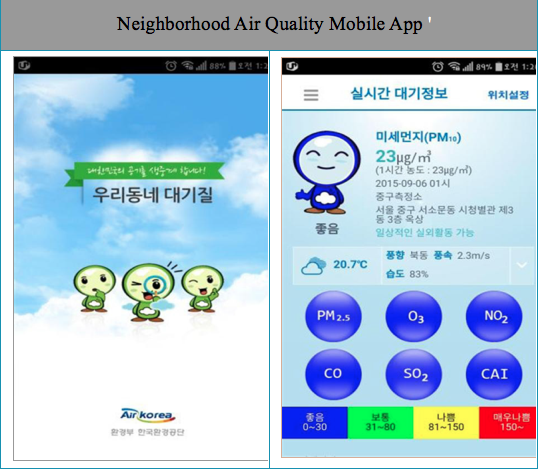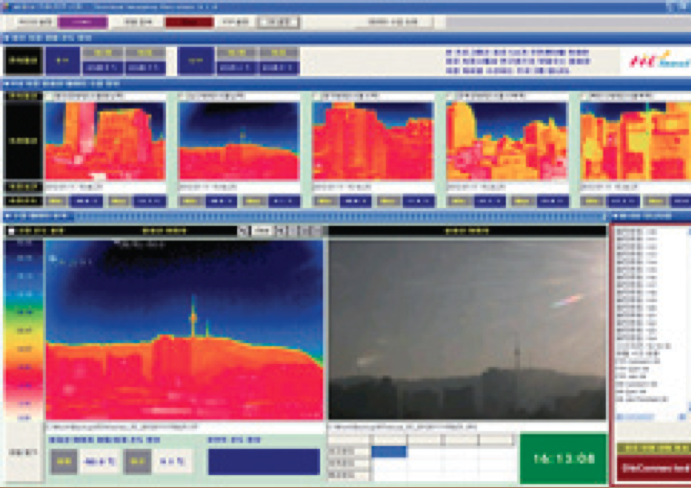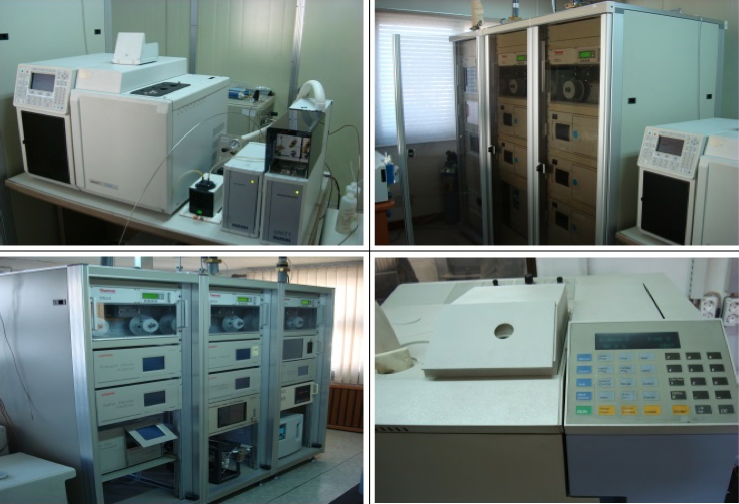Air Pollution Monitoring Network
Policy Implementation Period
According to domestic regulations on the installation and operation of this network, it is largely divided into two sections - one for general measurement (with a total of 10 networks) and one for intensive measurement (with a total of 7 networks). Stations engaged in general measurement can be further categorized as belonging to either a general or special air pollution measurement network. General monitoring stations check for SO₂, CO, NOX, O₃, and PM10. The stations are then further categorized into national or local, depending on their operational type.
Figure 1. Categories within the Domestic Air Pollution Measurement Network
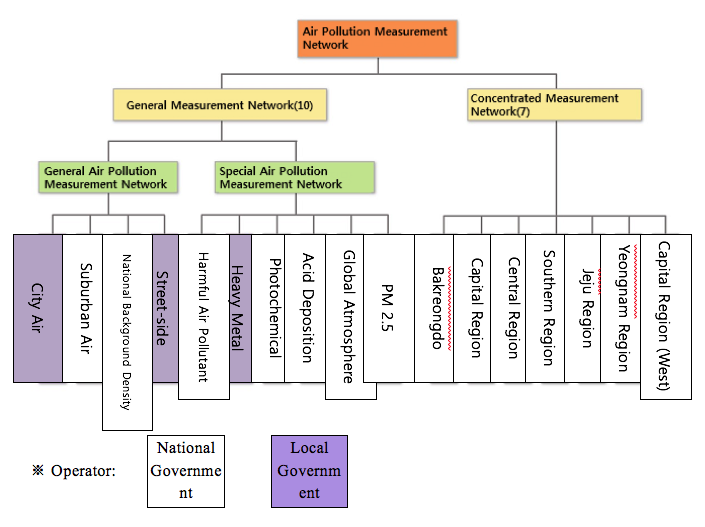
*Source: Ministry of Environment, Air Pollution Monitoring Network Installation and Operation Manual, 2011
Seoul had 4 measurement stations in 1973. Currently, there are 45, operating 65 air pollution measurement networks. The 25 gu-districts in the city are categorized into central, northeast, northwest, southwest, and southeast regions for air pollution analysis and management. There is at least 1 monitoring network installed for each district. Of the 6 types of measurement networks, the following stations have been recorded: 25 city, 14 road-side, 10 photochemical, 5 heavy metal, 10 acid deposition and 1 visible distance measurement station.
Table 1. Seoul City Air Pollution Measurement Network Stations (2015)
| Category | Total | City | Street-side | Photo chemical |
Heavy Metal |
Acid Deposition | Visible Distance |
| Total | 65 | 25 | 14 | 10 | 5 | 10 | 1 |
Source: Seoul City Air Management Department
Figure 2. Regions in Seoul’s Air Pollution Measurement Network
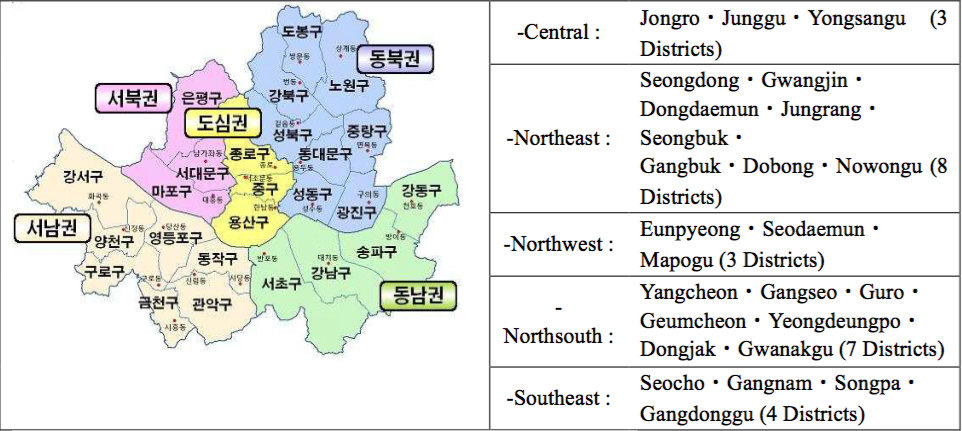
Seoul operated the following number of air pollution measurement stations until 2008: 27 city monitoring, 2 clean zone, and 9 road-side. As Seoul’s air pollution is largely affected by the metropolitan area as well as China and the northwest monsoon, the monitoring stations have been re-organized to better understand and manage pollutants that travel long distances, their components, density and travel routes, pollutant statistics in border areas and at road-side. Seoul currently has 25 stations, 1 for each district. The city also operates 6 background monitoring stations: Gwanak Mountain station measures pollutants that travel long distances, Namsan station measures at high altitude, and Bukhan Mountain station measures air quality within the clean zone. Moreover, to manage the generational and changing statistics of pollutants from automobiles, 12 stations have been installed on expressways, with additional stations on exclusive median bus lanes and exclusive car lanes. There is currently a total of 14 road-side measurement stations. This brings the total to 45 stations in Seoul - 25 for the 25 gu-districts, 6 background, 14 street-side) for monitoring and management of air pollution.
Table 2. Seoul’s General & Special Air Pollution Measurement Stations
| Category | General and Special Air Pollution Monitoring Network | ||||||||||||
| General Air | Heavy Metal | VOC/BTEX | Acid Rain | Mercury | Ion | EC/OC | BC | PM-1 | Traffic Volume | HC | UV | ||
| City Air Quality Monitoring Station | 25 | 4 | 7 | 8 | 4 | 3 | 3 | 4 | |||||
| Road-side Air Quality Monitoring Station | 14 | 4 | 1 | 2 | 3 | 15 | 9 | ||||||
| City Background Monitoring Station | 6 | 1 | 1 | 1 | 1 | 1 | 4 | ||||||
| Other (Researcher) | 1 | 1 | 1 | ||||||||||
| Mobile Air Quality Monitoring Vehicle (6 Units) | 1 | 1 | |||||||||||
| Total | 47 | 5 | 12 | 10 | 5 | 4 | 5 | 2 | 8 | 3 | 15 | 10 | |
Seoul uses the air pollution measurement statistics to forecast situations and issue warnings on air pollution to the public, evaluate air quality, and find ways to improve it. The city will continue to build new monitoring stations, update old ones, add cutting-edge features and push for an integrated information system on air quality, so as to ultimately create the most reliable air quality management system possible.
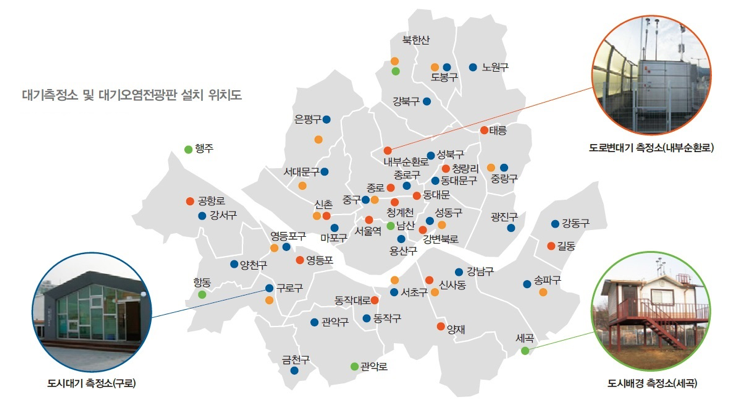
Reference: Seoul Policy Archive
Background Information
Air pollution in Korean urban centers continued to deteriorate over time, finally reaching a point at which it could no longer be ignored, and a variety of actions were taken to improve the situation. The Environmental Conservation Act was enacted in 1978, and the Environmental Office was created in 1980. A number of other actions and policies began to be considered.
The SMG also worked to improve air quality by expanding the provision of low sulfur fuel and other clean fuels, or by attaching purifiers to automobiles. However, the density of 1st pollutants exceeded general air quality standards.
To understand Seoul's air quality and analyze its pollution, it had to be measured at several locations at the same time. Therefore, the automatic air pollution measurement network was created. With it, the city began to measure its air quality in real time. An air pollution alert system was also created to provide forecasts and warnings for the public as air quality can have considerable impact on health. The air pollution statistics so measured are used in a variety of ways, such as to evaluate policies to reduce air pollution, understand whether environmental standards have been met, and provide information for forecasting models or analysis of air pollution trends.
Air pollution measurement stations have been placed around Seoul in locations that best represent each area's specific and idiosyncratic characteristics. These stations automatically measure air quality 24 hours a day, with the results sent to the Seoul Public Health and Environment Research Institute, and released to the general public through its website. The measured values are sent to SMG and the Ministry of Environment after a thorough validation process. To improve reliability, only statistics that have achieved more than 75% measured values during the designated period are considered valid.
Figure 4. Seoul’s Management System for Statistics on Air Pollution
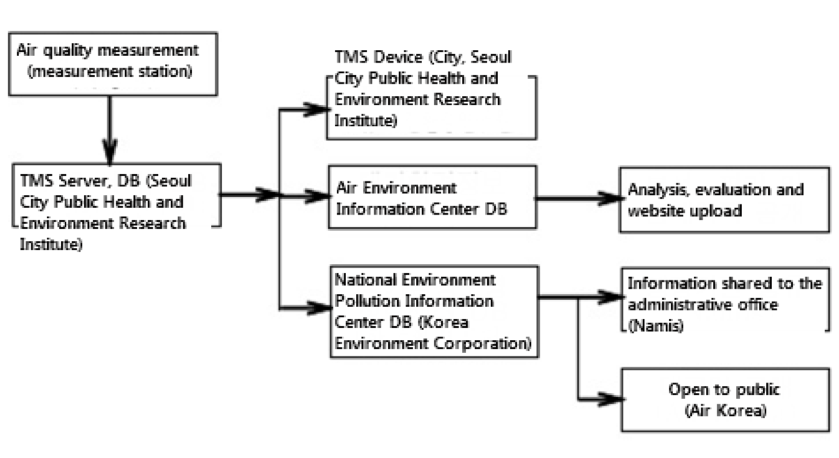
| Air pollution measurement (measurement station) |
TMS Device (City, Seoul City Public Health and Environment Research Institute) | Analysis, evaluation and website upload |
| TMS Server, database (Seoul City Public Health and Environment Research Institute) | Air Environment Information Center database | Information shared with the administrative office (Namis) |
| National Environment Pollution Information Center database (Korea Environment Corporation) | Open to public (Air Korea) |
The Importance of the Policy
The SMG began installing and operating these measurement stations in the late 1970s, to watch air pollutants and track changes in density. In the 1980s, semiautomatic measurement facilities were mostly used to observe pollutants. Starting in the late 1990s, the semiautomatic stations closed, and were replaced by automatic facilities.
In the 1990s, secondary pollutants such as acid rain, ozone, or photochemical smog became a new issue. The stations were then placed into two different networks: the general air quality measurement network or the special air quality measurement network, with the 2000s Air Quality Monitoring Network Plans. These plans are modified every 5 years, and reflect new needs for air quality monitoring. The monitoring system has been improved with additional monitoring tools for environmentally important pollutants.
Policy Objectives
The overall direction is to operate the general networks without human resources so the general, special and comprehensive networks can operate more efficiently. Comprehensive stations must be able to measure 2 or more pollutants, therefore requiring multiple facilities in the same location.
Stations that measure air pollutant concentrations aid better understanding of air quality in major areas, component analysis, and identification of the causes of pollutants. The stations include in-depth measuring and research functions.
The SMG is also strengthening its management of harmful pollutants such as PM2.5 or mercury. The networks have been expanded to include both density measuring networks and component measuring networks for PM2.5 as a way to assist with decisions on policy directions and evaluate whether or not the concentrations reach limits set by environmental standards, as PM2.5 was finally included in the environmental standard in 2015. Mercury is also measurable now, and a total of 4 mercury measuring facilities were installed in 2015. To strengthen monitoring of harmful heavy metals, the city has included fine dust in sampling at the heavy metal monitoring stations and added arsenic and beryllium.
Relevance with Other Policies
Figure 5. Seoul’s Air Environment Information Website
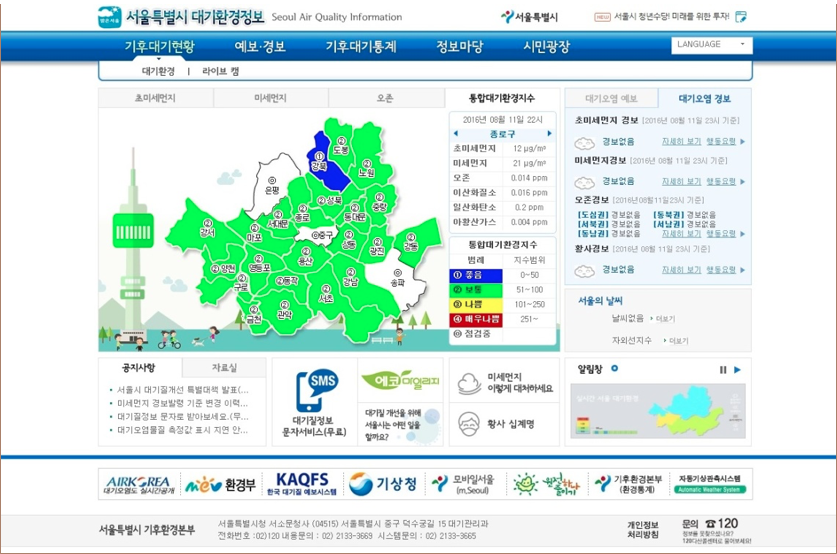
The Seoul Air Quality Information Service shows air pollution on a map for each district, with quality levels represented by color. People are able to sort the results for each monitoring station, area, pollutant type and duration of time.

Moreover, besides protecting health and minimizing damage to living environments, the data is utilized in forecasting and issuing warnings on air pollutants (fine dust, ozone), as well as better understanding air pollution and creating policies to improve air quality.
1) Fine Dust Forecasting & Warning System
Data obtained from air pollution measurement stations is used for air pollution warnings and a forecasting system to protect health. Fine dust forecasts inform the public of expected high pollutant densities. Warnings are issued after real-time measuring, notifying people quickly when air pollution reaches serious levels. The system aims to especially protect those with respiratory conditions, children and the elderly, all of whom are more sensitive to air pollution.
The microdust forecast and warning system was developed to respond to the rapid increase of automobiles and the influx of high-density microdust from China. The system notifies the public of recommended actions, including the use of public transportation. Companies that emit such pollutants can also be notified to cease operations.
Air pollution forecasts are divided into 5 levels: good, ordinary, slightly bad, bad, and very bad. Forecasts are provided at 6 p.m. and 7 a.m.
Table 3. Fine Dust Forecast System in Korea & Guidance for Citizens
| Category | Alert Level for Fine Dust Density (㎍/㎥) | |||||
| Good | Ordinary | Slightly Bad | Bad | Very Bad | ||
| Forecast Material |
PM10 | 0~30 | 31~80 | 81~120 | 121~200 | Higher than 201 |
| PM2.5 | 0~15 | 16~50 | 51~75 | 76~100 | Higher than 101 | |
| Action Guide |
Sensitive Group | - | Outdoor activity with caution, according to health conditions | Refrain from prolonged hard outdoor activity | Refrain from hard outdoor activity (People with respiratory disease, heart disease, elderly citizens) |
Restrict outdoor activity |
| General Citizen | - | - | Refrain from prolonged hard outdoor activity | Refrain from outdoor activity | ||
| *Permissible Level of Fine dust PM10 : 24 hours 100㎍/㎥, annual 50㎍/㎥, PM2.5 : 24 hours 50㎍/㎥, annual 25㎍/㎥ *Sensitive Group: Children, elderly, adult with respiratory or heart disease |
||||||
When the forecast is 'slightly bad' or worse, hospitals and senior citizens’ centers are notified. The elderly, children, and people with respiratory conditions are warned against outdoor activities or exercise. When it is 'bad' or worse, warnings are issued against driving and microdust-generating businesses are urged to adjust their operations. When it is 'very bad,' the superintendent of the Seoul Metropolitan Office of Education is notified to keep kids indoors, shorten the school day, or cancel school for the day.
Table 4. Details of the Fine Dust Alert System in Korea
| Target Pollutant | Alert Level | Issuing the Alert | Dismissing the Alert |
| PM10 | Watch | Considering the weather, when an automatic measurement station's hourly PM10 density is higher than 150㎍/㎥ for at least 2 hours. | Considering the weather factors in areas that have already had a 'watch' issued, when an automatic measurement station's hourly PM10 density is lower than 100㎍/㎥. |
| Warning | Considering the weather, when an automatic measurement station's hourly PM10 density is higher than 300㎍/㎥ for at least 2 hours. | Considering the weather factors in areas that have already had a 'watch' issued, when an automatic measurement station's hourly PM10 density is lower than 150㎍/㎥, then 'warning' changes to 'watch'. | |
| PM2.5 | Watch | Considering the weather, when an automatic measurement station's hourly PM2.5 density is higher than 90㎍/㎥ for at least 2 hours. | Considering the weather in areas that have already had a 'watch' issued, when an automatic measurement station's hourly PM2.5 density is lower than 50㎍/㎥. |
| Warning | Considering the weather, when an automatic measurement station's hourly PM2.5 density is higher than 180㎍/㎥ for at least 2 hours. | Considering the weather in areas that have already had a 'watch' issued, when an automatic measurement station's hourly PM2.5 density is lower than 90㎍/㎥ then 'warning' changes to 'watch'. |
When real-time statistics from the air quality measurement network shows a higher density than the standard, “watch” or ”warning” is sent out to advise against outdoor activities or classes. Schools are encouraged to take a day off and drivers are encouraged to leave their cars at home. Dust-generating businesses are advised to cease operations, and the roads are sprayed down with water.
Figure 6. Seoul Fine Dust Forecast & Warning Dissemination System
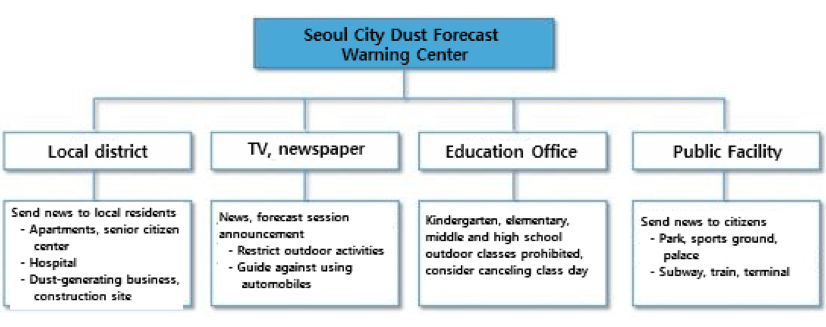
| Seoul City Dust Forecast Warning Center | |||
| Local districts | TV, newspapers | Education Office | Public Facilities |
| Send news to local residents - Apartments, senior citizens’ centers - Hospitals - Dust-generating businesses, construction sites |
News, forecast session announcement - Avoid outdoor activities - Advice issued against using automobiles |
Outdoor classes banned for kindergartens, elementarymiddle/high schools, principals urged to consider canceling classes for the day | Send news to citizens - Parks, sports arenas, palaces - Subways, trains, bus terminals |
Figure 7. Guidance for Citizens under Microdust Watches or Warnings
| Microdust Watch | Microdust Warning |
| Ÿ Sensitive persons are advised to avoid outdoor activity and stay indoors Ÿ The general public is advised to limit prolonged or intense outdoor activity (especially when experiencing irritated eyes or throat, or coughing) Ÿ If outdoor activity is unavoidable, wear a protective mask for yellow dust (people with lung disease should consult a doctor before going out even with a mask) Ÿ Avoid areas with heavy traffic Ÿ Limit outdoor classes at kindergarten and elementary school Ÿ Restrict access to public outdoor sports facilities Ÿ Encourage people in parks, sports facilities, palaces, terminals, trains and subways to avoid intense outdoor activities |
Ÿ Sensitive persons must not engage in outdoor activity (consult with doctor before going outside) Ÿ For the general public, avoid prolonged or intense outdoor activity (stay indoors if coughing or throat is sore) Ÿ If outdoor activity is unavoidable, wear a protective mask for yellow dust Ÿ Avoid areas with heavy traffic Ÿ Kindergartens and elementary schools to prohibit outdoor classes; school day to be shortened or canceled Ÿ Limit outdoor classes at middle and high schools Ÿ Public outdoor sports facilities to close for the day Ÿ Urge people in parks, sports facilities, palaces, terminals, trains and subways to avoid intense outdoor activities |
Figure 8. Neighborhood Air Quality Mobile App
Figure 9. Health Advisory when Microdust Density is High

2) Downtown Thermal Images Available Online
Since February 2009, the temperature of Seoul’s downtown area has been measured in real time at the Jongno-gu air pollution monitoring station with a thermographic camera. Such images are released to the public on the Seoul City Air Environment Information website (http://cleanair.seoul.go.kr). Temperatures in 5 directions (towards Namsan, Dongdaemun, Jonggak, Gyeongbokgung, and Bukhansan) are measured every 10 minutes, and the results displayed in color coding, from white to blue, so that the temperature can be understood at a glance.
In large cities like Seoul, “thermal islands” occur, which means the downtown areas have higher temperatures than other parts of the city. Surface temperatures of buildings have increased up to 59℃ (August 8, 2014), or about 30℃ higher than the highest outdoor temperature of 30.3℃. This thermal island effect is due to the different surface heat balance of buildings and roads, the increase of automobiles and fuel consumption (which generates heat), the increase of air pollutants, the greenhouse effect from pollutants in the atmosphere over the city, and skyscrapers that prevent the wind from blowing normally.
Figure 10. Thermal Images of Seoul Temperatures
Figure 11. Thermographic Camera at Jongno-gu Station

3) The Seoul Ozone Forecast & Warning System
Figure 12. Seoul Ozone Forecast & Warning System: Standards & Operating System
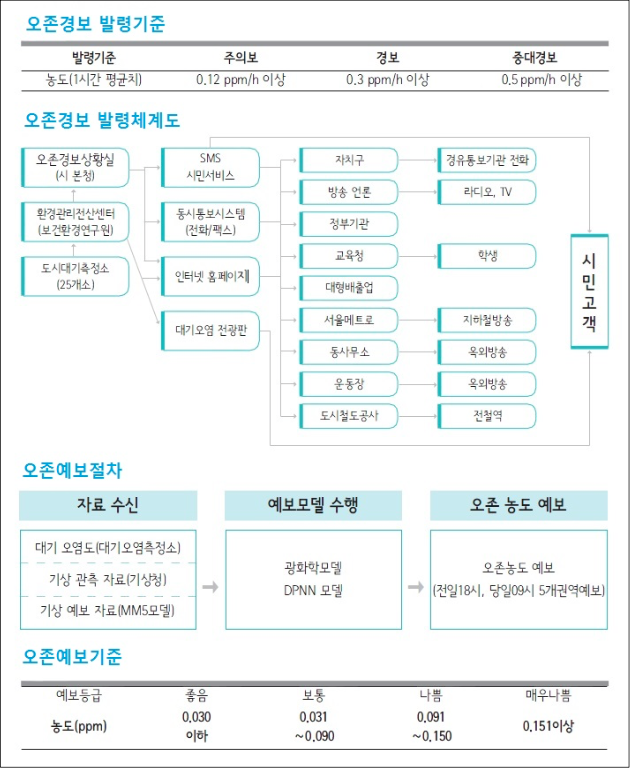
4) Air Pollution Information Boards (13 locations)
The Banpo and Seongsu Electronic Air Pollution Information Board has been running since December 1992, and took over from the SMG and Munrae electronic display boards, originally installed and operated by the Ministry of Environment, from May 1993. The Air Pollution Information Boards utilize the statistics gained from automatic monitoring networks to display air quality information in numbers to promote awareness of the environment and warn the public in severe situations. It also promotes the implementation of environmental policies and serve as environment watchers. Displayed in real time are the densities of certain pollutants, environment-related information and guidance regarding ozone or microdust warnings.
Figure 13. Example of an Air Pollution Information Board
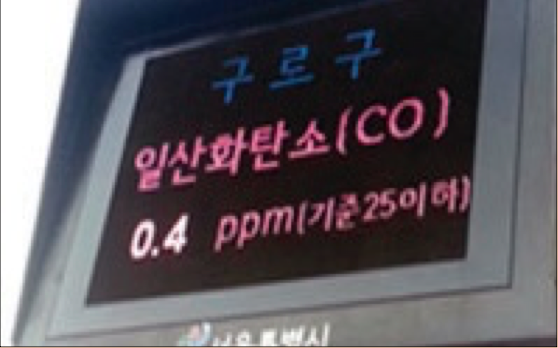
5) Microdust Information Via N Seoul Tower Lighting
The SMG also informs the public of pollution levels quickly and easily with N Seoul Tower's lighting. Beginning in May 2011, the tower's lighting remains blue when air quality is good, and turns red when air quality is bad. Different colors are displayed according to the specific conditions. The service begins after sunset and runs until 11 p.m. April to September, and until 10 p.m. the rest of the year. In February 2015, the SMG added PM2.5 and PM10 to its criteria for determining 'good’ air quality, as it declared its intention to reduce ultrafine particles by 20% by 2018.
Figure 14. N Seoul Tower Lighting Used to Inform People of Microdust Levels
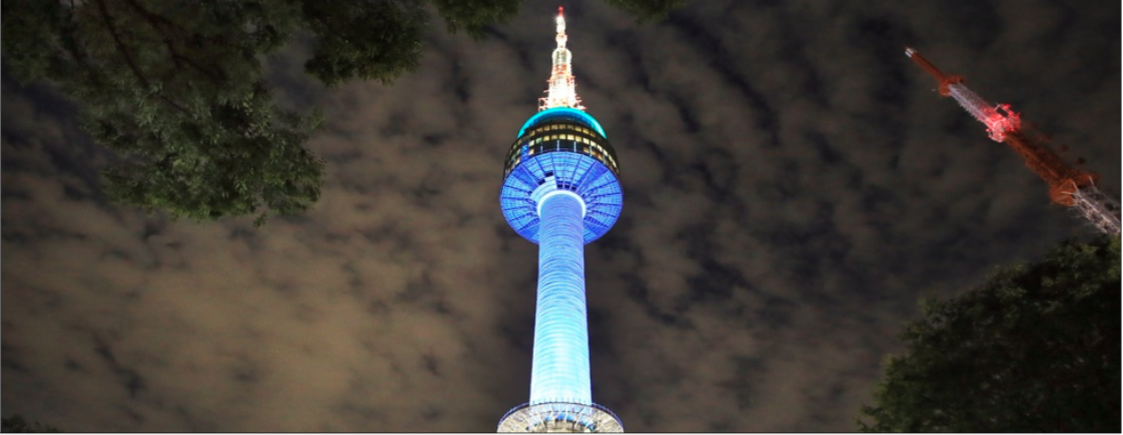
Figure 15. Seoul N Tower Lighting Corresponding to 4 Fine Dust Levels

Main Policy Contents
1) City Air Quality Measurement Network
According to the Manual on Installation & Operation of the Air Quality Measurement Network (2006), city air measurement stations are to be installed at "locations where the average air quality can be checked, while not directly affected by major pollutant generators." These are in places where the air best represents the concerns that exist about the area, and where there are no buildings, trees or plants to block the sensors. Sampling stations must be located far enough away from surrounding objects so that the distance to the object is more than twice its height, or where a straight line from the sampling port to the top of the object is at no less than 30° angle. In areas where buildings are concentrated, sampling stations should be installed at least 1.5m away from building surfaces. The sampling station should be between 1.5m and 10m off the ground.
City air measurement stations are located across Seoul approximately 5km apart in accordance with the TM (Transverse Mercator) coordinate system. They are located away from major roads so that major pollutant generators (automobiles) cannot directly affect the statistics, and are generally located on top of community centers or public offices.
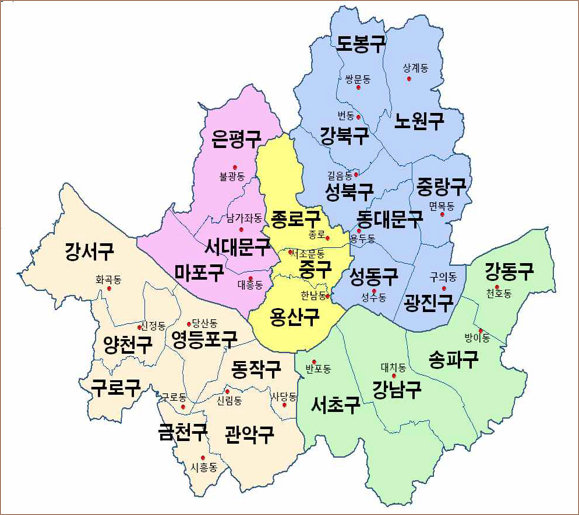
2) Road-side Air Quality Measurement Network
Road-side stations are located on roads with the heaviest traffic in Seoul, so as to monitor components of exhaust fumes. There are 14 measurement stations installed, collecting pollutants from automatic measurement facilities. The collected data is then used to evaluate roadside air pollution and the impact on the environment, and as the main basis for roadside air quality policies. Ten of the stations are at street-side, 2 at exclusive car lanes, and 2 at the median strip.
The road-side stations measure sulfurous acid gas, 13 air pollutants (NO, NO₂, NOX, O₃, CO, CH₄, n-CH₄, THC, SO₂, TSP, PM10, PM2.5, EC/OC), 6 weather factors (wind direction, wind speed, temperature, humidity, UV radiation, solar radiation) for a total of 17-20 elements, and the amount of traffic. The statistics are sent in real time to the Electronic Control Center of the SMG Research Institute of Public Health and Environment, the SMG Weather and Environment Center, the Ministry of Environment’s National Institute of Environmental Research and the Gyeongin Regional Environmental Office.
Figure 17. Road-side Measurement Station /Figure 18. Measurement Station at Exclusive Car Lane/Figure 19. Measurement Station at Median Strip

3) Heavy Metal Measurement Network
Some stations measure heavy metal density to understand environmental impact, or to come up with policy to control harmful heavy metals such as lead (Pb), cadmium (Cd), and chromium (Cr).
Mercury is measured every 24 hours by automatic facilities at Guro, Bangi, Nowon and Hannam. Heavy metals in the air can be discharged from a variety of locations, both artificial and natural. Usually, they are attached to dust and stay in the air. Even small amounts can harm the human body.
Samples are collected every second week of the month (24 hours), and every day during the yellow dust season. A High Volume Air Sampler is used, and in January 2013, the sampling method changed from TSP to PM10.
During regular sampling, inductive coupling plasma emission spectroscopy is used to measure a total of 19 elements, including lead (Pb), cadmium (Cd), chromium (Cr), copper (Cu), manganese (Mn), iron (Fe), nickel (Ni), arsenic (As), and beryllium (Be). During the yellow dust season, aluminum (Al), calcium (Ca), and magnesium (Mg) are added to the regular list.
4) Mercury Measurement Network
Mercury is the only metal that is liquid at room temperature, and accumulates in the soil, water and air. Air is a particularly important means for the material. More than 98% of mercury in the atmosphere is gas, which circulates around the earth, accumulates and reacts when it enters the ecosystem. It is very important to monitor mercury in real time.
Mercury levels in the air are monitored at 4 stations, and the measured values used as the basis for related policies.
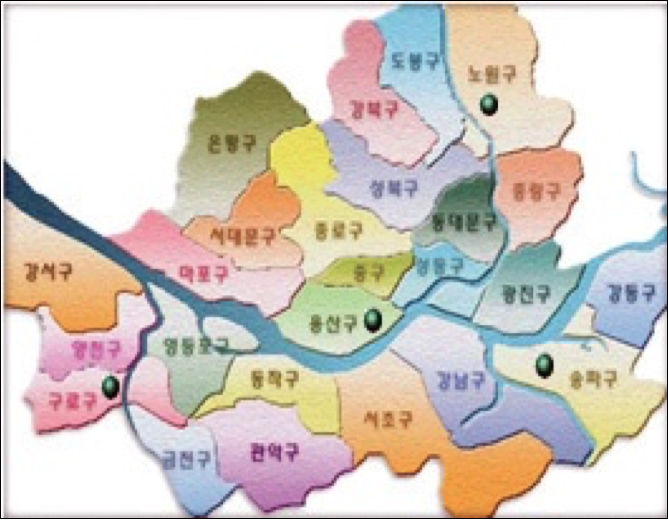
Acid deposition refers to all the pollutant materials that fall from the atmosphere to the ground due to the forces of gravity. There are two types: wet deposition and dry deposition. Wet deposition includes acid rain, snow and fog. Dry deposition includes PM2.5, NO₂, and SO42-.
The representative form of wet deposition is acid rain, which is when the rain's pH level is less than 5.6. Acid rain is created from sulfur oxides or nitrogenous compound reactions, and is a long-distance pollutant that can impact large areas. Acid rain can damage buildings, bridges and other important structures. After prolonged exposure, children and the elderly may suffer skin conditions. It damages the ecosystem as it inhibits water absorption by plants, inhibits natural decomposition of organic materials, and pollutes the water.
There have been 10 acid deposition measurement stations in the city since 1985. The stations also analyze ion composition, the major determinant of pH levels in rain. The statistics are used for related policies. Currently, eight stations are located in residential areas, while two others are in “clean” areas (Bukhansan and Bangi). Bukhansan station operates as a background station.
Figure 21. Location of Acid Rain Measurement Stations
.png)
6) Photochemical Pollutant Measurement Network
Seoul and other large cities have high population densities and heavy traffic, resulting in high densities of ozone and nitrogen dioxide (NO₂). Most ground-level ozone is created by photochemical reactions between nitrogenous compounds and volatile organic compounds (VOCs). It is very important to control NO₂ and VOCs as a precursor to controlling ozone density. VOCs are discharged from contamination sources, which creates secondary aerosols through photochemical reaction, increases ozone density, leading to the issuance of ozone 'watch' notifications.
There are 10 photochemical stations around Seoul. They make their measurements every hour, and the data is used in designing related policy.
Currently there are 5 VOC stations (Gangseo, Gwangjin, Guro, Jongro, Bukhansan) and 5 BTEX (Benzene, Toluene, Ethylbenzene, Xylene) stations (Songpa, Jungrang, Dongjak, Haengju, Segok) engaged in continuous measurement.
Figure 22. Seoul’s Photochemical Pollutant Measurement Network

7) City Background Quality Measurement Network
As the Bukhansan measurement station is located in a clean area that is not significantly affected by pollutants, data it collects is used in comparisons with air quality in the city’s urban areas. The Bukhansan station recorded low annual pollution levels in 2014, when compared to air quality in the city, for all elements except ozone, which is largely due to the high sunlight penetration ratio, resulting in high solar radiation. Therefore, the NO to NO₂ ratio (NO₂/NO) is higher than found in the city. NO is involved in O₃ extinction and NO₂ in O₃ creation, which is why O₃ equilibrium concentrations are high in areas around Bukhansan station.
Figure 23. Air Pollution Comparison for Each Monitoring Network (in 2014)
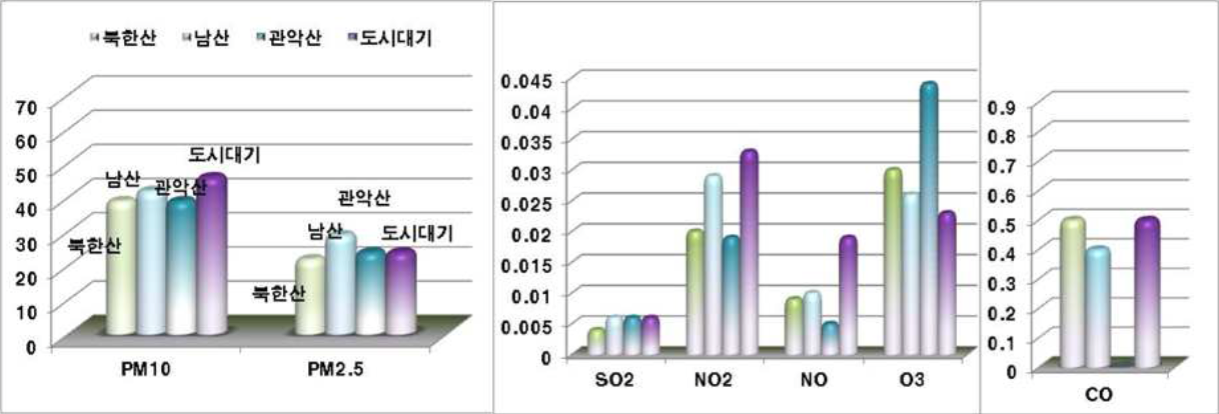
Technical Details
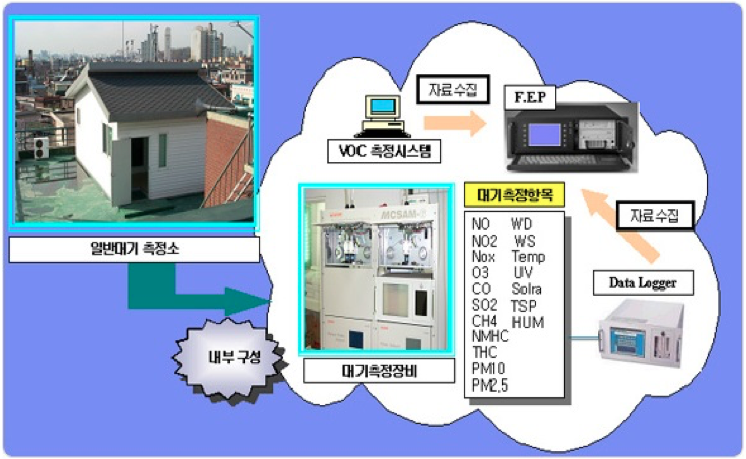
Source: http;//env.seoul.go.kr
Source: Seoul Development Institute. 2008. "Study on Approaches to Effectively Link Traffic and Air Pollution Monitoring Data"
When the location of a measurement station is considered ineffective or the host building is being removed, the station will be relocated as close as possible to the original location. The final spot is decided after considering the views of the network’s evaluation group.
Policy Effects
The microdust forecasting and warning system has been in operation since February 2005, in accordance with the Ordinance on Microdust Forecasts and Warnings. The ultrafine particle (PM2.5) warning system has been operation since October 2013, supplementing the SMG’s efforts to protect human health.
Fine dust forecasts in 2014 had a high average accuracy rate of 70.5%: 68.5% for the forecasts issued the day before, and 72.6% for those issued on the day. Microdust forecasts are provided to related organizations such as local governments, the police, and the Office of Education, as well as anyone wanting to receive the information via SMS (text message). In 2014, there were 2 microdust watches, 6 ultrafine particle watches, and 14 (preliminary) watches released.
Challenges and Solutions
There are a variety of challenges in terms of securing locations for measurement stations due to the fact that Seoul is a metropolitan area. Since the stations are mainly located on top of public offices or schools, it is questionable whether their statistics truly and accurately reflect the area's air quality. Large apartment complexes or commercial buildings partly interfere with the measurements at some stations.
Such stations need to be moved, and mobile air monitoring vehicles can also serve for certain durations to identify better locations once reliable results are obtained from those locations.
Efforts have also been made to measure harmful carcinogenic pollutants, with low density. Strenuous efforts are made to establish and implement relevant policies to secure various monitoring elements and accurately evaluate the impact of pollutants on public health and enhance the reliability of station measurements.
